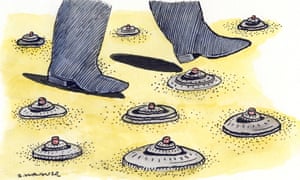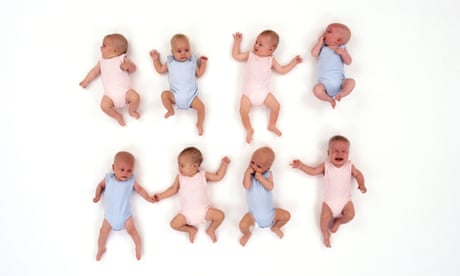'People will forgive you for being wrong, but they will never forgive you for being right - especially if events prove you right while proving them wrong.' Thomas Sowell
Search This Blog
Showing posts with label gender. Show all posts
Showing posts with label gender. Show all posts
Monday, 1 July 2024
Wednesday, 11 January 2023
Saturday, 24 April 2021
Tuesday, 21 February 2017
We’re doomed by the identity trap, damned when we try to escape
Nesrine Malik in The Guardian


Diane Abbott: misogyny and abuse are putting women off politics
Since then, she has been forced to go further, revealing this weekend that she does not walk or drive around her constituency as freely as she used to because, in the wake of Jo Cox’s murder, the death threats she receives can’t be shrugged off any more. It was a piece in which she used the word “I” for the first time in respect of her identity – it wasn’t about her profession or her political views. It is this forced “coming out” by Abbott as a black woman in public life that was disheartening.
Contrary to the view so widely held on the right, of this country being in the grip of a constantly aggrieved professional-victim class, few people actually like to talk about their experience of receiving abuse. It is uncomfortable and excruciating and diminishing, and above all a distraction when one just wants to get on with one’s business.
It is also, as many who are on the receiving end of such onslaughts (including myself) can testify, boring and predictable to have to keep running the gauntlet between attack and defence. There is another, silencing fear, as the bile swirls and rises around you: that you come across as attention-seeking or fragile. Above all, you want to show that the blows have not landed.
But when somebody occupies a public position, not speaking out becomes an abdication. It is a decision that is never taken lightly because it plays into the hands of the racists and misogynists whose ultimate motivating animus is to disabuse you of the notion that you can ever be anything but a woman who does not know her place or a member of an inferior race.
Oh but now you wince at the N-word. Come on now, you might say, let’s not get carried away and blow it all out of proportion. And besides, Abbott is hardly a flawless political figure who doesn’t deserve criticism. OK, she gets compared to a monkey and is the butt of her male colleague’s jokes about being too unattractive to hug, but what about sending her child to private school?
This is the line of argument that enables the masking of abuse behind legitimate criticism of an individual or their views. As if calling for a tree strong enough to carry her weight so she can be hanged, as was said, is a logical follow-on from any of her failings or political hypocrisies.
And then there are the accusations of playing the race card or the gender card – both denying that the abuse is real, and blaming the victim for using their minority status as a shield of deflection. It is a closed loop, a circular firing squad. You either accept the abuse with grace, turn the other cheek, or invite more abuse and derision for speaking out against it. The logical conclusion is that the only winning move is not to play.
It is ultimately this potential chilling effect that forces people to break their silence. Abbott said she had never complained until now. And she will have known of the potential cost to her stature, not to mention the possibility that her perceived vulnerability might encourage trolls further.
But ultimately, she said, she went into politics “to create space for women and other groups who have historically been treated unfairly”. It is only by creating this space that the abuse will subside, and that an individual like Diane Abbott will no longer be an offending novelty who is seen to only represent her own narrow racial or gender interests, rather than the people who elected her.

Diane Abbott on abuse of MPs: 'My staff try not to let me go out alone'
She and others like her are obliged to confront one of the most persistent political myths: that identity politics is a divisive phenomenon that actively seeks to separate minorities or women from the mainstream, conferring on them dispensation to act with impunity because any criticism is automatically bigotry. It is a notion that fails to recognise what is obvious, which is that identity is dictated from above. Abbott’s defining character as a black woman is imposed and kept alive by others, not by her. She has spent decades integrating into the mainstream.
Women or minorities aren’t droning on about discrimination and abuse because they’re snowflakes demanding special treatment. They do so because they keep being limited, circumscribed, told that they cannot have roles in public life that extend beyond their identity. But then they are condemned when they respond in terms of what is being attacked. But what else can one do? Hannah Arendt said: “If one is attacked as a Jew, one must defend oneself as a Jew.”
Playing identity politics, as critics describe it, seems less an offensive ploy than a defensive posture, akin to raising your arms to cover your face when it is repeatedly being punched.
The whole affair exemplifies the precariousness of how to deal with what is now an epidemic. Silence is not an option. Even those not personally distressed have a duty towards others – those younger, more vulnerable or just made of different stuff – to clear the way for them to claim their rightful positions in public life. But there is also a risk that by doing so, any progress minorities or women have made to break out of their pen is undermined. It is a quiet stranglehold. Diane Abbott is trying to break free of it, but at what price?

Illustration by Andrzej Krauze
Diane Abbott wrote a powerful article in these pages last week about the hatred she receives. Whatever one thinks of her politics, the veteran Labour MP has for decades been a fireball of public service. But her star has always been followed by a comet tail of toxic vapour. This personal abuse is at times snide and implied, at other times explicit, vicious and unprintable. But it is a constant in her political life, following her round, undermining her, consistently framing her in terms of her gender and her race.
Abbott’s article came just days after she received an exceptional and sustained amount of personal abuse over the article 50 vote, culminating in a leaked text sent by Brexit secretary David Davis, in which he made derogatory comments on her appearance. Her article was necessary and timely, but something about her speaking out made my heart sink. It felt like defeat; the ultimate feeding of the trolls. It is important to look beyond the headlines and understand the significance of what happened.
The fact is that her tormentors had hounded this most resilient of characters to a point where she finally cracked and, breaking a longstanding habit in a 30-year career of not commenting on personal insults, she laid it all out. She was forced to sound an alert, warning that something must be done before we get to the point in our democracy where women and minority candidates, already low in number, are bullied out of the political arena altogether.
Diane Abbott wrote a powerful article in these pages last week about the hatred she receives. Whatever one thinks of her politics, the veteran Labour MP has for decades been a fireball of public service. But her star has always been followed by a comet tail of toxic vapour. This personal abuse is at times snide and implied, at other times explicit, vicious and unprintable. But it is a constant in her political life, following her round, undermining her, consistently framing her in terms of her gender and her race.
Abbott’s article came just days after she received an exceptional and sustained amount of personal abuse over the article 50 vote, culminating in a leaked text sent by Brexit secretary David Davis, in which he made derogatory comments on her appearance. Her article was necessary and timely, but something about her speaking out made my heart sink. It felt like defeat; the ultimate feeding of the trolls. It is important to look beyond the headlines and understand the significance of what happened.
The fact is that her tormentors had hounded this most resilient of characters to a point where she finally cracked and, breaking a longstanding habit in a 30-year career of not commenting on personal insults, she laid it all out. She was forced to sound an alert, warning that something must be done before we get to the point in our democracy where women and minority candidates, already low in number, are bullied out of the political arena altogether.

Diane Abbott: misogyny and abuse are putting women off politics
Since then, she has been forced to go further, revealing this weekend that she does not walk or drive around her constituency as freely as she used to because, in the wake of Jo Cox’s murder, the death threats she receives can’t be shrugged off any more. It was a piece in which she used the word “I” for the first time in respect of her identity – it wasn’t about her profession or her political views. It is this forced “coming out” by Abbott as a black woman in public life that was disheartening.
Contrary to the view so widely held on the right, of this country being in the grip of a constantly aggrieved professional-victim class, few people actually like to talk about their experience of receiving abuse. It is uncomfortable and excruciating and diminishing, and above all a distraction when one just wants to get on with one’s business.
It is also, as many who are on the receiving end of such onslaughts (including myself) can testify, boring and predictable to have to keep running the gauntlet between attack and defence. There is another, silencing fear, as the bile swirls and rises around you: that you come across as attention-seeking or fragile. Above all, you want to show that the blows have not landed.
But when somebody occupies a public position, not speaking out becomes an abdication. It is a decision that is never taken lightly because it plays into the hands of the racists and misogynists whose ultimate motivating animus is to disabuse you of the notion that you can ever be anything but a woman who does not know her place or a member of an inferior race.
Oh but now you wince at the N-word. Come on now, you might say, let’s not get carried away and blow it all out of proportion. And besides, Abbott is hardly a flawless political figure who doesn’t deserve criticism. OK, she gets compared to a monkey and is the butt of her male colleague’s jokes about being too unattractive to hug, but what about sending her child to private school?
This is the line of argument that enables the masking of abuse behind legitimate criticism of an individual or their views. As if calling for a tree strong enough to carry her weight so she can be hanged, as was said, is a logical follow-on from any of her failings or political hypocrisies.
And then there are the accusations of playing the race card or the gender card – both denying that the abuse is real, and blaming the victim for using their minority status as a shield of deflection. It is a closed loop, a circular firing squad. You either accept the abuse with grace, turn the other cheek, or invite more abuse and derision for speaking out against it. The logical conclusion is that the only winning move is not to play.
It is ultimately this potential chilling effect that forces people to break their silence. Abbott said she had never complained until now. And she will have known of the potential cost to her stature, not to mention the possibility that her perceived vulnerability might encourage trolls further.
But ultimately, she said, she went into politics “to create space for women and other groups who have historically been treated unfairly”. It is only by creating this space that the abuse will subside, and that an individual like Diane Abbott will no longer be an offending novelty who is seen to only represent her own narrow racial or gender interests, rather than the people who elected her.

Diane Abbott on abuse of MPs: 'My staff try not to let me go out alone'
She and others like her are obliged to confront one of the most persistent political myths: that identity politics is a divisive phenomenon that actively seeks to separate minorities or women from the mainstream, conferring on them dispensation to act with impunity because any criticism is automatically bigotry. It is a notion that fails to recognise what is obvious, which is that identity is dictated from above. Abbott’s defining character as a black woman is imposed and kept alive by others, not by her. She has spent decades integrating into the mainstream.
Women or minorities aren’t droning on about discrimination and abuse because they’re snowflakes demanding special treatment. They do so because they keep being limited, circumscribed, told that they cannot have roles in public life that extend beyond their identity. But then they are condemned when they respond in terms of what is being attacked. But what else can one do? Hannah Arendt said: “If one is attacked as a Jew, one must defend oneself as a Jew.”
Playing identity politics, as critics describe it, seems less an offensive ploy than a defensive posture, akin to raising your arms to cover your face when it is repeatedly being punched.
The whole affair exemplifies the precariousness of how to deal with what is now an epidemic. Silence is not an option. Even those not personally distressed have a duty towards others – those younger, more vulnerable or just made of different stuff – to clear the way for them to claim their rightful positions in public life. But there is also a risk that by doing so, any progress minorities or women have made to break out of their pen is undermined. It is a quiet stranglehold. Diane Abbott is trying to break free of it, but at what price?
Friday, 13 January 2017
Spot the gender of your future child 26 weeks before conception
Sarah Knapton in The Telegraph
Craving sweets, early morning sickness and a watermelon-shaped stomach are all said to indicate that a woman will give birth to a baby girl.
But an intriguing new study suggests that it is possible to determine the sex of a baby months before it is even conceived.
Scientists in Canada discovered that a woman’s blood pressure at around 26 weeks before conception predicts if she will give birth to a boy or a girl. Higher systolic blood pressure signals she will deliver a boy while lower suggests a girl.
Dr Ravi Retnakaran, endocrinologist at Mount Sinai Hospital in Toronto, said: “It suggests that a woman's blood pressure before pregnancy is a previously unrecognised factor that is associated with her likelihood of delivering a boy or a girl.”
The team made the connection while trying to work out what determines the ratio between girls and boys in a population.
 The sex ration of a population can change depending on societal change CREDIT:GETTYIMAGES-DV1953025.JPG
The sex ration of a population can change depending on societal change CREDIT:GETTYIMAGES-DV1953025.JPG
Several studies have shown that stressful events such as wars, natural disasters and economic depression can change the proportion of boys and girls in a country.
The difference occurs because in stressful times one gender is more likely than the other to survive through pregnancy. So even though the conception sex ratio remains at 50:50, the birth ratio will alter depending on which sex is stronger.
In the new study the mean systolic blood pressure reading for women who had boys was 106 mm Hg, compared to 103 mm Hg for those who had girls, in the months leading up to conception.
“When a woman becomes pregnant, the sex of a foetus is determined by whether the father’s sperm provides an X or Y chromosome and there is no evidence that this probability varies in humans,” added Dr Retnakaran
“What is believed to vary is the proportion of male or female fetuses that is lost during pregnancy
“This study suggests that either lower blood pressure is indicative of a mother’s physiology that is less conducive to survival of a male foetus or that higher blood pressure before pregnancy is less conducive to survival of a female foetus.
“This novel insight may hold implications for both reproductive planning and our understanding of the fundamental mechanisms underlying the sex ratio in humans."
 A simple blood pressure test could give some indication on what sex a baby will beCREDIT: ANTHONY DEVLIN
A simple blood pressure test could give some indication on what sex a baby will beCREDIT: ANTHONY DEVLIN
For the study, 1,411 newly-married Chinese women were recruited all who were trying to become pregnant. Their blood pressure was checked at around 26 weeks before conception and they were followed through pregnancy. Overall the women gave birth to 739 boys and 672 girls.
After adjustment for age, education, smoking, Body Mass Index (BMI) , waist, cholesterol, triglycerides and glucose, mean systolic blood pressure before pregnancy was found to be higher in women who subsequently had a boy than in those who delivered a girl.
Fertility expert Prof Charles Kingsland, of Liverpool Women’s Hospital, said: “We have been aware that more male fetuses miscarry than females and more females are born for obvious biological reasons, namely you need more women in the world to have children.
“There is also some evidence that you are more likely to miscarry a boy when you are compromised either by health or environmental issues. So I suppose, blood pressure changes in these circumstances might affect conception of different sexes.
“This study is therefore very interesting. However it does not take into account the potential physiological aspects of race. Will those changes be the same in the Caucasian or Afro Caribbean populations in the world. And what if you want a girl? Do you just go and live in Syria for a few months?”
However some experts were skeptical about the results.
Geoffrey Trew a consultant in Reproductive Medicine and Surgery at the Hammersmith Hospital in west London said: “I haven't heard anything like this before.
“I would be very surprised that a BP measurement , which is notoriously variable, could dictate sex 26 weeks before, some reptiles can have sex differences due to temperature changes at the time of early fetal growth , but not 26 weeks beforehand.”
The study was published in the American Journal of Hypertension.
Craving sweets, early morning sickness and a watermelon-shaped stomach are all said to indicate that a woman will give birth to a baby girl.
But an intriguing new study suggests that it is possible to determine the sex of a baby months before it is even conceived.
Scientists in Canada discovered that a woman’s blood pressure at around 26 weeks before conception predicts if she will give birth to a boy or a girl. Higher systolic blood pressure signals she will deliver a boy while lower suggests a girl.
Dr Ravi Retnakaran, endocrinologist at Mount Sinai Hospital in Toronto, said: “It suggests that a woman's blood pressure before pregnancy is a previously unrecognised factor that is associated with her likelihood of delivering a boy or a girl.”
The team made the connection while trying to work out what determines the ratio between girls and boys in a population.
 The sex ration of a population can change depending on societal change CREDIT:GETTYIMAGES-DV1953025.JPG
The sex ration of a population can change depending on societal change CREDIT:GETTYIMAGES-DV1953025.JPGSeveral studies have shown that stressful events such as wars, natural disasters and economic depression can change the proportion of boys and girls in a country.
The difference occurs because in stressful times one gender is more likely than the other to survive through pregnancy. So even though the conception sex ratio remains at 50:50, the birth ratio will alter depending on which sex is stronger.
In the new study the mean systolic blood pressure reading for women who had boys was 106 mm Hg, compared to 103 mm Hg for those who had girls, in the months leading up to conception.
“When a woman becomes pregnant, the sex of a foetus is determined by whether the father’s sperm provides an X or Y chromosome and there is no evidence that this probability varies in humans,” added Dr Retnakaran
“What is believed to vary is the proportion of male or female fetuses that is lost during pregnancy
“This study suggests that either lower blood pressure is indicative of a mother’s physiology that is less conducive to survival of a male foetus or that higher blood pressure before pregnancy is less conducive to survival of a female foetus.
“This novel insight may hold implications for both reproductive planning and our understanding of the fundamental mechanisms underlying the sex ratio in humans."
 A simple blood pressure test could give some indication on what sex a baby will beCREDIT: ANTHONY DEVLIN
A simple blood pressure test could give some indication on what sex a baby will beCREDIT: ANTHONY DEVLINFor the study, 1,411 newly-married Chinese women were recruited all who were trying to become pregnant. Their blood pressure was checked at around 26 weeks before conception and they were followed through pregnancy. Overall the women gave birth to 739 boys and 672 girls.
After adjustment for age, education, smoking, Body Mass Index (BMI) , waist, cholesterol, triglycerides and glucose, mean systolic blood pressure before pregnancy was found to be higher in women who subsequently had a boy than in those who delivered a girl.
Fertility expert Prof Charles Kingsland, of Liverpool Women’s Hospital, said: “We have been aware that more male fetuses miscarry than females and more females are born for obvious biological reasons, namely you need more women in the world to have children.
“There is also some evidence that you are more likely to miscarry a boy when you are compromised either by health or environmental issues. So I suppose, blood pressure changes in these circumstances might affect conception of different sexes.
“This study is therefore very interesting. However it does not take into account the potential physiological aspects of race. Will those changes be the same in the Caucasian or Afro Caribbean populations in the world. And what if you want a girl? Do you just go and live in Syria for a few months?”
However some experts were skeptical about the results.
Geoffrey Trew a consultant in Reproductive Medicine and Surgery at the Hammersmith Hospital in west London said: “I haven't heard anything like this before.
“I would be very surprised that a BP measurement , which is notoriously variable, could dictate sex 26 weeks before, some reptiles can have sex differences due to temperature changes at the time of early fetal growth , but not 26 weeks beforehand.”
The study was published in the American Journal of Hypertension.
Saturday, 19 November 2016
Susan Smith complains after judges ordered her four-year-old to stop wearing girls’ clothes
Ashifa Kassam in The Guardian
A Canadian mother has called for lawyers and judges to receive better training on gender identity after two judges in the province of Alberta ordered her four-year-old child to stop wearing girls’ clothing in public.
The order was first issued last year by a family court judge in Medicine Hat, a small city of 63,000. Some three months later, the clothing restriction was upheld by a second judge.
Susan Smith said her child was born male but began identifying as a girl soon after turning two years old. “First I thought it was really cute. It was like ‘oh no no honey, you’re a boy,” said Smith, whose name has been changed in order to protect the child.
But her child only became increasingly insistent. Smith, who is separated from the child’s father but shares custody, struggled with how to respond. “I was kind of questioning, is my kid doing this for attention? What is going on?”
Then one evening, after her child surprised her by asking when their penis would fall off, Smith sat the child down. “I told them sweetheart, you were born with a penis, so you’re a boy. You will always have your penis, therefore you’ll always be a boy.”
A few nights later her child woke her up, visibly upset. “It was along the lines of mom, I don’t want to be a boy,” said Smith. “And then it went to almost shouting. I’m going to cut my penis off, I want my penis off.”

Trans children allowed to express identity 'have good mental health'
Concerned for the safety of the child, she sought professional help and began researching gender dysphoria, a condition that causes a person to experience extreme distress because of a disconnect between their birth sex and gender identity.
Soon after, Smith decided she would acknowledge the child’s choice of gender identity. “I was going to do whatever I could to validate and support them and to be that one person they could go to,” Smith said.
After conferring with the staff and children at her child’s preschool and daycare, she began offering her child the option of wearing either male, female or gender neutral clothing. Her child consistently chose stereotypically female clothing and opted to go by a female name, she said.
According to Smith, her child’s confidence bloomed, while the yelling, screaming and unhappiness disappeared. “Everything was perfect,” she said.
Throughout the process, Smith had kept the father informed. But about one month after she began allowing her child to choose their clothing, Smith was served court documents. The father – who Smith said blamed her for the child’s anxiety and confusion around gender – was seeking full custody of the child.
The first interim order, issued in December 2015, said Smith could continue as the primary caregiver. But the judge said the child would not be permitted to wear clearly female clothing in public. The child could choose to do so in private, the order said.
The ruling came as a shock to Smith. “I’m the person that knows this kid more than anybody in this world,” she said. “It’s like telling your kid who has a huge thing for being Spiderman – and that was allowed to have a Spiderman backpack, a Spiderman shirt, a Spiderman pencil and a Spiderman cup – and all of a sudden you come along and you take all of that away. And you give them a Batman cup.”
In February, a second judge upheld the ruling, and also granted the father primary custody of the child, with Smith allowed limited access.
In September, a third provincial judge overturned the clothing restriction after consulting with a parenting expert. The child, said the judge, must now be provided with male and female clothing options and then can choose from these options.
Smith said the consecutive orders – all issued within a nine-month span – have taken a toll on the child, who is now five. “When my child was removed and placed with Dad, they internalised it and took it like they did something wrong. They were being bad because the judge doesn’t like them to be a girl.”
She plans to file a judicial complaint with the province, demanding that all legal representatives in Alberta – from judges to lawyers – be better trained on gender identity. “If they were properly educated and aware of the severe consequences and the turmoil this has had on my child, they could not ethically say it’s in the best interests of the child.”
Ron Hewitt, the executive director of Alberta’s provincial court system, said judges study and refer to a number of sources of information to keep current on the law and other matters that apply to their role as judges. “Our court carries on extensive professional development for the judges of the court in all areas as appropriate,” he said.

Transgender children: the parents and doctors on the frontline
While Alberta’s justice minister, Kathleen Ganley, could not comment on the specifics of the case, she pointed to an amendment made last autumn to the province’s Human Rights Act, which saw gender identity and gender expression added as prohibited grounds of discrimination. “This is now law, and we expect all Albertans to follow the law,” she said in a statement.
Smith said her complaint – and the remedy she’s demanding – will do little to help her in her ongoing court battle to regain custody of her child. But she hopes it will prevent other families from experiencing what she and her child have been through in the past year. “This has been so hard on my kid,” she said, her voice shaking as she fought back tears.
“My kid then started talking about dying. At four, they didn’t feel that the world wanted them to be a girl. That they were no good,” she said. “My kid was asking me, mom, does it hurt to die, how can I die, where would I go when I die? Mom now that you know, when I die, grow me in your belly but grow me as a girl, not with a penis. Because now you know.”
A Canadian mother has called for lawyers and judges to receive better training on gender identity after two judges in the province of Alberta ordered her four-year-old child to stop wearing girls’ clothing in public.
The order was first issued last year by a family court judge in Medicine Hat, a small city of 63,000. Some three months later, the clothing restriction was upheld by a second judge.
Susan Smith said her child was born male but began identifying as a girl soon after turning two years old. “First I thought it was really cute. It was like ‘oh no no honey, you’re a boy,” said Smith, whose name has been changed in order to protect the child.
But her child only became increasingly insistent. Smith, who is separated from the child’s father but shares custody, struggled with how to respond. “I was kind of questioning, is my kid doing this for attention? What is going on?”
Then one evening, after her child surprised her by asking when their penis would fall off, Smith sat the child down. “I told them sweetheart, you were born with a penis, so you’re a boy. You will always have your penis, therefore you’ll always be a boy.”
A few nights later her child woke her up, visibly upset. “It was along the lines of mom, I don’t want to be a boy,” said Smith. “And then it went to almost shouting. I’m going to cut my penis off, I want my penis off.”

Trans children allowed to express identity 'have good mental health'
Concerned for the safety of the child, she sought professional help and began researching gender dysphoria, a condition that causes a person to experience extreme distress because of a disconnect between their birth sex and gender identity.
Soon after, Smith decided she would acknowledge the child’s choice of gender identity. “I was going to do whatever I could to validate and support them and to be that one person they could go to,” Smith said.
After conferring with the staff and children at her child’s preschool and daycare, she began offering her child the option of wearing either male, female or gender neutral clothing. Her child consistently chose stereotypically female clothing and opted to go by a female name, she said.
According to Smith, her child’s confidence bloomed, while the yelling, screaming and unhappiness disappeared. “Everything was perfect,” she said.
Throughout the process, Smith had kept the father informed. But about one month after she began allowing her child to choose their clothing, Smith was served court documents. The father – who Smith said blamed her for the child’s anxiety and confusion around gender – was seeking full custody of the child.
The first interim order, issued in December 2015, said Smith could continue as the primary caregiver. But the judge said the child would not be permitted to wear clearly female clothing in public. The child could choose to do so in private, the order said.
The ruling came as a shock to Smith. “I’m the person that knows this kid more than anybody in this world,” she said. “It’s like telling your kid who has a huge thing for being Spiderman – and that was allowed to have a Spiderman backpack, a Spiderman shirt, a Spiderman pencil and a Spiderman cup – and all of a sudden you come along and you take all of that away. And you give them a Batman cup.”
In February, a second judge upheld the ruling, and also granted the father primary custody of the child, with Smith allowed limited access.
In September, a third provincial judge overturned the clothing restriction after consulting with a parenting expert. The child, said the judge, must now be provided with male and female clothing options and then can choose from these options.
Smith said the consecutive orders – all issued within a nine-month span – have taken a toll on the child, who is now five. “When my child was removed and placed with Dad, they internalised it and took it like they did something wrong. They were being bad because the judge doesn’t like them to be a girl.”
She plans to file a judicial complaint with the province, demanding that all legal representatives in Alberta – from judges to lawyers – be better trained on gender identity. “If they were properly educated and aware of the severe consequences and the turmoil this has had on my child, they could not ethically say it’s in the best interests of the child.”
Ron Hewitt, the executive director of Alberta’s provincial court system, said judges study and refer to a number of sources of information to keep current on the law and other matters that apply to their role as judges. “Our court carries on extensive professional development for the judges of the court in all areas as appropriate,” he said.

Transgender children: the parents and doctors on the frontline
While Alberta’s justice minister, Kathleen Ganley, could not comment on the specifics of the case, she pointed to an amendment made last autumn to the province’s Human Rights Act, which saw gender identity and gender expression added as prohibited grounds of discrimination. “This is now law, and we expect all Albertans to follow the law,” she said in a statement.
Smith said her complaint – and the remedy she’s demanding – will do little to help her in her ongoing court battle to regain custody of her child. But she hopes it will prevent other families from experiencing what she and her child have been through in the past year. “This has been so hard on my kid,” she said, her voice shaking as she fought back tears.
“My kid then started talking about dying. At four, they didn’t feel that the world wanted them to be a girl. That they were no good,” she said. “My kid was asking me, mom, does it hurt to die, how can I die, where would I go when I die? Mom now that you know, when I die, grow me in your belly but grow me as a girl, not with a penis. Because now you know.”
Tuesday, 24 June 2014
What makes a slut? The only rule, it seems, is being female
It's a warning more than a word: a reminder to women to adhere to sexual norms or be punished

Sandra Fluke heard it when she talked about insurance coverage for birth control. Sara Brown from Boston told me she was first called it at a pool party in the fifth grade because she was wearing a bikini. Courtney Caldwell in Dallas said she was tagged with it after being sexually assaulted as a freshman in high school.
Many women I asked even said that it was not having sex that inspired a young man to start rumors that they were one.
And this is what is so confounding about the word "slut": it's arguably the most ubiquitous slur used against women, and yet it's nearly impossible to define.
The one thing we do know about "slut" is that it's the last thing a woman should want to be. Society is so concerned over women and girls' potential for promiscuity that we create dress codes, school curricula, even legislation around protecting women'ssupposed purity. Conservative columnists opine that women having sex is tantamount to a "mental health crisis", and magazine stories wonder if we're raising a generation of "prosti-tots".
Leora Tanenbaum, the author of SLUT! Growing Up Female with a Bad Reputation, told me that "a 'slut' is a girl or woman who deviates from norms of femininity. The 'slut' is not necessarily sexually active – she just doesn't follow the gender script."
This nebulous, unquantifiable quality of the slur is what makes it so distressing – there's no way to disprove something that has no conclusive boundaries to begin with. And because it's meant to be more of an identity than a label, it's a term not easily shaken off. "Slut" sticks to a person in a way that "asshole" never will.
So what makes you a slut? It seems the the only hard and fast rule is that you have to be a woman.
Men, of course, are immune – absent, really – from the frenzy of concern. For instance, a new study out of the University of Michigan showed that teen girls who "sext" are called sluts while boys who do the same remain free-from judgement. In another example, the American Medical Association breathlessly released a study in 2006 with the headline "Sex and Intoxication More Common Among Women on Spring Break", intended to warn women about their "risky" behavior while on break – but there was nothing about the men the majority of these young women would supposedly be having all this drunken sex with.
As always, women are sluts and men are, well, men.
For those who haven't had the pleasure of being called promiscuous, it may be hard to understand just how profound an impact it can have. Women's value and morality are closely – though wrongly – tied to their sexuality. So "slut" (or any of its variations) is an accusation with power behind it.
When multiple attackers videotaped themselves brutally raping an unconscious teen girl in California, for example – stopping to take dance breaks and find new objects to penetrate the young woman with – the first trial resulted in a hung jury because the defense argued she was promiscuous. "The things she wanted done were done", argued one lawyer. Another asked the jury: "Why was her vagina and anus completely shaved? Sex! She's a sexual person!"
The accusation doesn't have to be that explicit to have real power. Cherice Moralez –raped by her 49 year-old teacher when she was just 14 – was called "older than her chronological age" by the judge in the trial – a more diplomatic way of saying she had it coming. Her attacker was sentenced to 30 days in jail. Moralez later took her own life.
Multiple girls have taken their own lives of late after being "slut-shamed" – an indication that the slur shows little sign of waning in the damage it does personally.
Tanenbaum, whose forthcoming book is I Am Not a Slut: Slut-Shaming in the Age of the Internet, said that many of the girls she interviewed "had intentionally embraced the 'slut' label as a badge of honor to advertise their sexual empowerment."
But, she added, "they ended up losing control of the label when their peers turned it against them".
Broader efforts to "reclaim" the word – via marches like SlutWalks, for instance – have largely failed. While the anti-rape protests that spread across the country a few years ago were popular in terms of attendance and media coverage, and I was an early supporter, many women felt the word "slut" was irredeemable - especially women of color, for whom racist stereotypes about their supposed innate promiscuity always presented a unique danger.
The "slut" idea hurts women politically as well. A safe contraceptive and a cancer vaccinewere both held up for years because of fears they would make women "slutty", and anti-choice legislators and activists insist that that abortion providers are in the "business" of promiscuity – and use that accusation as a way to defund critical health care providers like Planned Parenthood.
So, what's a "slut", then? It's any of us, and all of us – especially those of us who step out of line in some way real or imaginary. It has little to do with the number of our sexual partners, or the way we dress or flirt, or if we take birth control or not.
It's a warning more than a word – a reminder to women that we must adhere to the narrow standards of femininity and sexuality set out for us, or be punished accordingly. And in that way, the real meaning of "slut" is terrifyingly clear.
Wednesday, 28 September 2011
Subscribe to:
Comments (Atom)
